Do you want an SEO tool that enables you to do keyword research, track keyword ranking, check backlinks, see what competitors are doing, as well as perform an SEO audit for your site or blog?
If yes, then let me recommend a tool that I have used for over a decade and has been trusted by professional bloggers and SEO agencies worldwide. SEMrush is the tool I’m talking about.
What Is SemRush And What Exactly It Does?
Digital marketing research tool SEMRush helps you gain a better understanding of precisely how and where your competitors have had success, so that you can replicate the results for your business as well.
Semrush is a competitor’s keyword research tool used for keyword research, backlink analysis, SEO audits, and more. We can easily find profitable keywords for any niche using this tool.
There is no doubt that Semrush is one of the top search engine marketing tools that can help bloggers and marketers at all levels. With this tool, you can also check the traffic of your competitors.
It is easy to spy on your competition with Semrush. Using this tool, you can estimate their current website traffic, top keywords, backlinks, and more.
This tool not only offers keyword research and competition analysis, but also showcases organic research, search positions, backlinks, and ad research all in one place.
Semrush is undoubtedly among the best SEO tools recommended by SEO experts, and I use it daily to check my rankings and keyword positions. According to SEO & blogging experts, it’s also one of the best tools for keyword research.
Our Results Using SEMrush (528% Increase in Traffic!) –
Our website traffic increased substantially after we decided to focus 100% of our efforts on content marketing and SEO. Our past strategy was to write articles and youtube videos we felt inspired to write – without considering how anyone would find those articles.
When we began utilizing SEMrush insights to optimize our content and write SEO-friendly content, the following happened:

With our new SEO-focused and process-driven research and publishing system, we published our first blog post on July 18, 2018.
As you can see from the above chart, traffic has increased in a reasonable but incremental manner over the last five months.
Within just 7 months, the traffic increased by 528% and our efforts started paying off in a big way.
That’s enough about us, let’s find out if SEMrush is right for you.
In-depth Semrush Review 2023 –
With no further ado, here is Semrush’s unbiased guide for 2023 with a Free 30-day Trial.
Using Semrush For Competitors Analysis –
Researching competitors is one of the primary reasons why most bloggers use Semrush. You are already being watched by your competitors if you rank well for a few keywords on Google. Now it’s your turn to spy on them!
Semrush can help you identify the top performing keywords that drive most of the search traffic to your competitor’s website. One of the most important success factors that distinguishes a successful blog from a normal one is competitor analysis.
Understanding your competitor’s weaknesses and strengths will help you to understand strategic ways to compete against them. Here’s where Semrush pro account helps you conduct thorough competitors research.
For one of our websites, here is the organic search traffic keyword report. With this tool, you not only get detailed information about the keywords they have, but you also get an estimate of the traffic they get every day.

Similar to the above, you can enter any competitor’s URL to see their current website traffic. Semrush usually gives you accurate information about traffic a website receives. This site updates its databases very frequently, so you will always get up-to-date information or data.
Finding Question Keywords Using Keyword Magic Tool –
“Question keywords” are one of the easiest ways to get targeted visitors to your site from search engines like Google.
So, guess what? There is already a tool from Semrush called Keyword Magic that finds question keywords.
What Are Question Keywords?
A question keyword is a keyword where searchers search for information by using question-based phrases.
Here is an example of question keywords to help you understand.

For the question based phrase, Google is directly providing a featured snippet answer.
The following are examples of keyword phrases based on questions for various niches:
- If you’re in the real estate industry: “how to become a real estate agent”?
- If you’re in the fitness industry: “what’s the best weight to age ratio”?
- If you’re into the SEO industry: “what’s the optimal bounce rate for a website”?
Did you get the point?
When you offer helpful and compelling answers to tough questions, you position yourself as a source that people can trust, better than your competitors. Question keywords come into play here.
Finding and targeting question keywords in your content can offer you many benefits
- You can easily get featured snippets (because you’re answering specific questions and Google loves it)
- With their help, you can easily achieve top rankings (even if there is competition).
- From search engines, you can receive highly targeted traffic
- Their conversion rate is really good
So now that you understand why question keywords are so important, let’s talk about the most important part: how to find them.
How To Find Question Keywords Using Semrush Keyword Magic Tool?
However, you can find questions using sites like Quora, Answer The Public, etc, but they are not as reliable and do not provide a great deal of search metrics (such as number of monthly searches, related keywords, competition, and CPC value).
Those are all things that Semrush’s keyword magic tool does for you and helps you with.
Here’s how you can use the Semrush keyword magic tool to find question based keywords, regardless of the industry you are in.
Go to Keyword Magic tool from Semrush (grab 30 days free trial to be able to use it) and enter a keyword. On the right side, you’ll notice the ‘Questions’ button.

Click on it to see a list of primary seed keywords that contain your targeted keyword. This is how it looks;

From the above, you can see that there is a ton of highly relevant question-based keywords that you can include in your content to generate a lot of blog post ideas.
The Keyword Magic tool also allows you to see the monthly search volume, trend, keyword difficulty (KD) and so on to help you choose the right question keyword.
If you’re wondering what Keyword Difficulty (KD), let me explain briefly.
In Semrush, KD means Keyword Difficulty, which helps you find keywords with less competition. According to Semrush, KD is a score between 0 and 100 (with 100 being the hardest spot to rank for and 0 being the easiest).
It’s a good idea to pick keywords with lower KD (below 30 or 50) and stay away from keywords with KD over 80 and 90 since they are really tough to rank for.
To put it simply, Keyword Magic Tool lets you do the following things:
- You can get over 20 billion keyword suggestions
- The Keyword Grouping feature allows you to segment your keywords based on topics
- Keyword Analyzer allows you to save your favorite keywords for future use
- Semrush allows you to export your selected keywords to other tools
- You can easily create up to 50 target keyword lists with keyword magic tool
Quick Tip –
If you are doing keyword research with Semrush, don’t select the keywords with search volume more than 1000 per month, as they will require a lot of work to get the traffic your site needs. Choose keywords with a monthly search volume of 500 to 1000 (or even less) so that even if you have a new website, you can rank on the top 3 or even the first page of search results.
Few Important Metrics For Competitor Analysis Using Semrush –
You should keep in mind these few important elements as you research your competitors and analyze their content using Semrush.
- Keyword: These are the keywords your competitor’s site ranks for
- Pos: A keyword position for a website in search engines such as Google. It is generally based on how the website is distributed geographically (which also changes according to keyword positions).
- Volume: The number of searches for this specific keyword per month
- CPC: Cost per click is the average value for the specific keyword (to easily determine its worth)
- URL: This is the URL to which the keyword is driving traffic
- Competition: It shows the level of competition of advertisers for this keyword (you should focus on picking keywords with a low number as a low number means your keyword is easier to rank for)
- Trend: This graph shows the overall search pattern for this keyword over the past 12 Months.
- Results: This is the number of results from the search engine (lower results are better again)
Find the Highest Traffic Competitors Keywords –
This tool helps you find out what are the most performing keywords for any of your competitors’ websites. Quite fascinating. This means you now have a clear understanding of which keywords are driving traffic to your competitors.
A great idea is to study some of your competitors’ websites using Semrush and note down their top performing keywords in an Excel Sheet. Once you have these keywords, you can use them in future contents.
This is your chance to increase traffic to your website. In this way, if you are good at creating high quality content, you may be able to beat all your competitors in search rankings.
Using Semrush for keyword research –
You can use Semrush to discover the top performing and unused keywords for your blog to improve your search engine ranking.
Are you having difficulty finding the best keywords to increase traffic to your website? Don’t worry, Semrush can help you find the most profitable keywords in any niche. Whether you want SEO tools for PPC ads, Google AdWords, Bing Ads, or simply to find better keywords for blog posts, Semrush is a great option.

Simply type in any keyword related to the topic of your blog and Semrush will provide the most accurate data. In the above screenshot, you can see the volume of the keyword along with the distribution of the CPCs and the trend for blogging tips.
These details will allow you to determine whether or not the keywords you enter are a good match for your website. Additionally, Semrush also provides you with a list of all the Phrase Match keywords, question based keywords, and Related keywords that you can use to increase your blog traffic. Take a look at the screenshot below to get a better understanding.

This tool has 150 plus phrase match keywords and another 1990 plus keywords related to blogging tips, as shown above. This will allow you to find the best and most profitable keywords for your websites and blogs.
Remember: Semrush updates its database multiple times each day to give you accurate information about the keyword ranking positions and traffic of websites. Thus, you can find the latest reports on keyword phrases for your targeted seed keywords list.
Semrush Backlink Checker Tool –
This backlink checker tool from SEMrush is great overall.
That’s because SEMrush has a huge link index. Furthermore, it is quick at finding new pages and links. This is all you need in a link analysis tool.
While I prefer Ahrefs’ link analysis UI, SEMrush is still very effective. Specifically, they have dozens of filters that you can use to find the backlinks that you want to find.
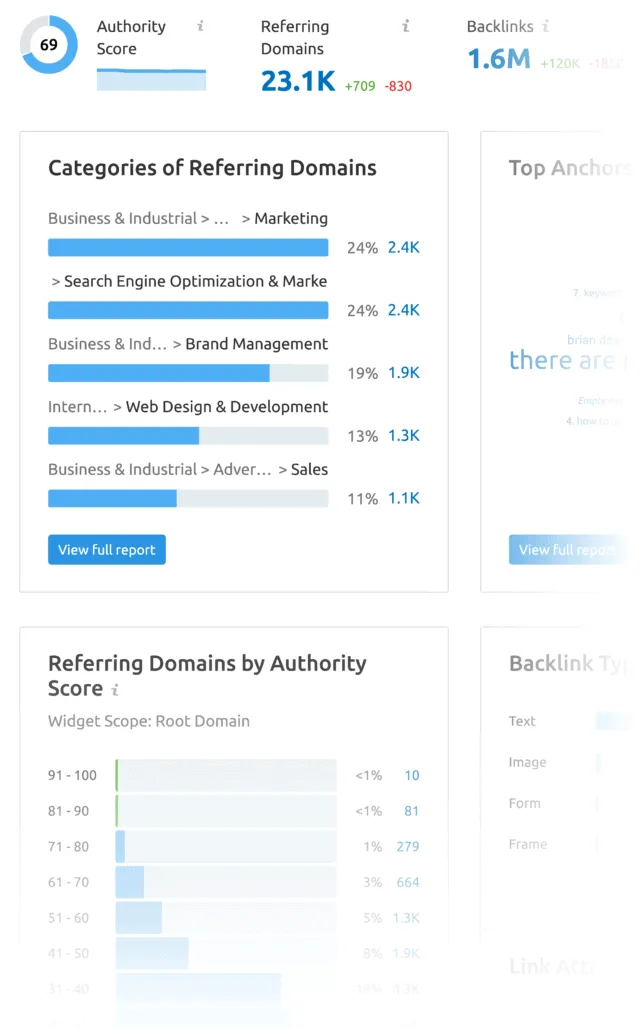
It’s my experience that 90% of the backlink checker tools online do not give accurate results (for the simple reason that the majority of them are free and are not updated frequently).
As opposed to Semrush, which is an advanced marketing tool that helps you analyze the links of the websites you enter. With this software, you get accurate results that can be used to discover effective strategies for building links.
For instance, if you know who links to your favorite blog or competitor site, you can approach them and ask them to link to yours too (if you provide useful content, they will do this).
That’s where a free Semrush account can help. If you enter any of your competitor’s URL in Semrush’s backlinks section, it gives you the details of their Page Score (a new feature), the titles of their backlinks and URL of their source and more information like Anchor text, External links, and Internal links.

Are you curious about the incoming links (including do-follow links) your competitors are receiving? If you enter their domain, this tool will display all the total backlink data they have.

In order to get more organic traffic or to analyze the website traffic of your competitors, you always need one important piece of data, and that is backlink analysis. With the information regarding how many links are pointing to a site, you will be able to easily design the best SEO strategy for your site.
With Semrush, you can analyze backlinks easily. To gain an insight into the number of quality backlinks of any site, it shows all the links as a pie chart option in both dofollow and nofollow.
In addition, it shows the total number of backlinks a site has including the referring domains. Using this metric when analyzing the backlinks of a site can boost your overall search traffic.
Using this backlink analysis report, you can also identify opportunities for link building. Here is how it works.
When you click on “Referring Domains” under “Backlinks” on the Semrush dashboard, it will display a list of all the domains that are pointing to your competitors’ sites.
All you have to do is email all the bloggers who are already linking to your competition (by providing them with value).
To increase your search engine traffic and ranking for any keyword, you need backlinks. The only effective way for any website to achieve higher Google ranking is through link building.
When you have access to the full version of Semrush, you will be able to find all the link opportunities from competitor websites. It will be possible to analyze how many backlinks a site gets, including the backlinks that are dofollow.
When you find out who is linking to your competitors, you can use guest posts or blogger outreach strategies to build backlinks to your own sites.
Using this tool, you can find most of the opportunities for link building. This tool is used by most SEO experts to crush their competition. It all depends on how you use this tool.
After all, search engine traffic depends entirely on finding the right link building opportunities. The more links you get from different sites, the better your organic traffic will be. Once you have a list of every site you can get links from, you will see a huge improvement.
Additionally, they offer a Backlink Audit Tool that allows you to remove all the toxic links that could lower your ranking.
Here’s how the overview looks;
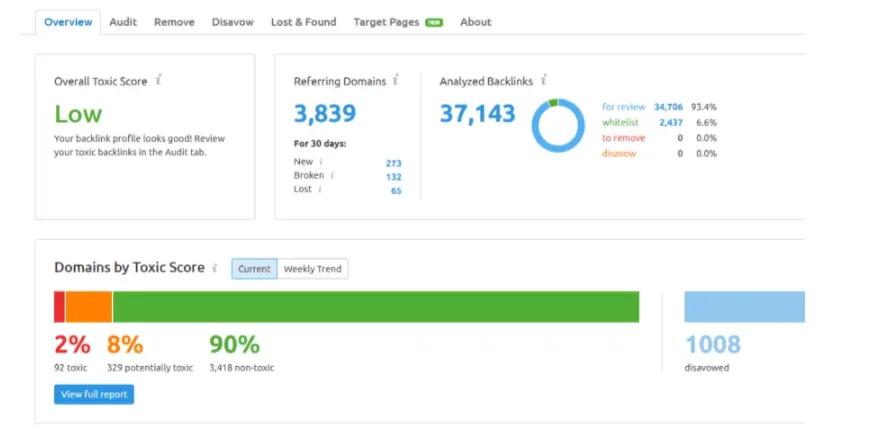
It shows our overall toxic score as high, so we can click on the “Toxic links” and use Google’s Disavow tool to remove all the bad backlinks.
Using Semrush To Perform Full Site Audit –
It’s another SEMRush feature you can use for your own site or as an SEO agency, you can offer white-labeled reports to clients. A single site audit can reveal a variety of technical SEO changes you can make to the target site to boost its ranking, therefore improving the technical SEO of your site.
Semrush will audit your website to detect any issues that are affecting your search rankings, such as:
- Crawl errors
- Missing headers
- Overuse of keywords
- Slow-loading content
- Duplicate content
- SSL problems
It will give you a list of tasks to complete – and in an extra feature, it allows you to export tasks to the popular project management application Trello (you could also use Zapier to export tasks to another tool).
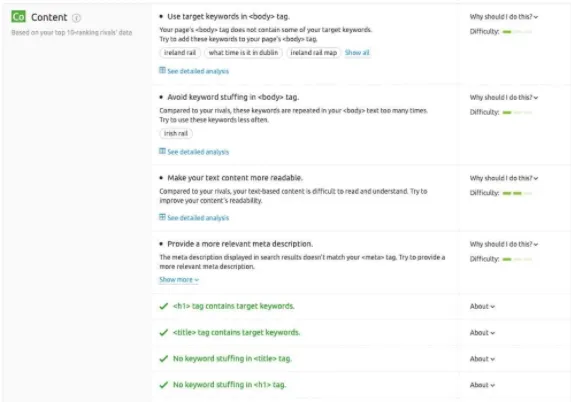
Semrush’s on-page SEO tool is one of my favorites, since it scans your entire site and offers you actionable suggestions (in order of priority) for improving each page.
There can be suggestions on how to improve them:
- The steps to make your page a featured snippet on Google
- What you can do to improve the body copy and meta description of your website
- Getting backlinks from the right websites
- What keywords to add
- Content length
- Strategies for internal linking
…………..And much, much more.
A great thing about Semrush’s site audit features is that it not only informs you what actions to take, but also why you should take them.
A ‘Why should I do this?’ link accompanies each suggestion. When clicked, it provides a plain English explanation for each recommendation.

The site audit feature is simply amazing!
Rank Tracking –
It is a process of monitoring website performance in search engines for a specific keyword over time called ‘rank tracking’ or ‘position tracking’.
Semrush lets you track rankings in its position tracker section – you just enter a domain name and a keyword(s) you’d like to monitor, and you’ll be given a report showing which keywords your site ranks for. A country-by-country tracking option is also available.
Over time, as more information about your website flows into Semrush, you will be able to track your progress towards ranking highly for your chosen phrases.
Furthermore, you can enter competitor website information into Semrush’s position tracker tool, which allows you to compare (over time) how your site is performing for chosen keywords to those of your competition.
Also, you will receive regular email updates about your ranking progress — for example, email notifications when a particular piece of content drops out of the top 10 results.
Overall, Semrush’s position tracking functionality is strong – there is nothing to complain about.
Domain Analysis –
A basic domain analysis is the first step in most SEO projects. From an SEO perspective, this can be described as a quick overview of the ‘quality’ of a domain.
When conducting domain analysis, you usually do it on your own website – to see where SEO improvements can be made – or on a competitor’s, to see how difficult it will be to get a better ranking in search engines (or to find ways of doing so).
Also, consider performing domain analyses on sites in order to determine if it might be worthwhile to approach the owner for a link from the site to yours. This is because external links (or backlinks) from high-quality sources to your website can boost your rankings.
The Semrush ‘domain overview’ section allows for easy domain analysis: just enter a URL in this section, and you will get an immediate view of how the domain is performing in search results.

The provided metrics include:
- The ‘authority score’
- The total monthly traffic on the website
- The total number of keywords the website ranks for
- The best performing keywords
- The total number of external links — backlinks — pointing to the website
- Anchor text commonly used in links to the website
- Display advertising statistics
- Competitor websites
The ‘authority score’ provides you with the quickest understanding of a site’s quality out of the metrics above.

Semrush calculates it based on:
- backlink data (quantity & quality of links pointing to it)
- Data on organic search traffic and keyword positions, including organic search traffic
- Site traffic data (visits per month).
In Semrush’s interface, the authority score used to be a bit buried, but recently it was moved to the domain overview section, so you can get an immediate sense of how Semrush views a specific domain.
The important thing to remember about the domain overview statistics is that while the majority of them are based on hard data, the traffic figures are estimates – and my experience indicates that they are not always 100% accurate.
(I based this observation on my comparison of traffic estimates from Semrush and Google Analytics data for websites I have access to).
Semrush is fair in that it does not claim to be 100% accurate in its traffic estimates, and actually estimates how accurate the traffic statistics are likely to be (low, medium or high).
Semrush is fair in that it does not claim to be 100% accurate in its traffic estimates, and actually estimates how accurate the traffic statistics are likely to be (low, medium or high).

Additionally, it is useful to have the ability to break things down by country so that you can understand where a website performs well.
Only thing I wish Semrush included in its domain overview is a ‘traffic cost’ figure (which shows you how much it would cost to display ads generating equivalent amounts of traffic). Other tools, including Ahrefs, display this as part of their domain overview analyses. Semrush provides this information, but you must go to a separate ‘Organic Research’ page to access it.
However, as a whole, Semrush’s domain overview is incredibly helpful, and this feature alone offers a great deal of insight into how a website is doing from an SEO standpoint.
Content Marketing Toolkit –
With Semrush’s content marketing toolkit, you can plan, create, and distribute content efficiently.
This tool can do everything from suggesting topics to analyzing the performance of your content. In addition, it could help boost your content marketing strategy by providing you with competitive intelligence.
Now let’s take a closer look at each feature.
Content Ideas –
Semrush’s first content marketing tool is Topic Research. This is a powerful, all-in-one tool that provides numerous options to help you generate content ideas.
This is my personal favorite tool and I use it to research and plan my blog content.
Would you like to know why?
Here are a few reasons why:
- Simple to use, it takes just a few moments to begin. All you need to do is enter a topic or keyword and it will give you content ideas based on those topics.
- In addition to the main topic or keyword, you will also get a detailed list of all related subtopics.
- Moreover, it provides metrics to help you decide which titles are most effective in your content, as well as suggestions on what to title your content.
Are you curious to know what the best part is?
Additionally, you get a list of “how,” “what,” “why,” and other questions people ask about that topic. This essentially serves you your target audience’s needs and challenges on a platter.
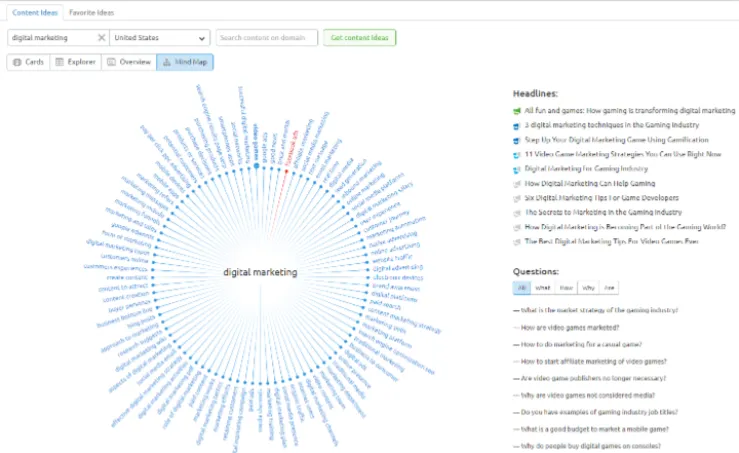
Pro Tip: Answer the most frequently asked questions about a topic in your content to get more engagement.
Content Optimization –
Many people aren’t aware that Semrush also has an SEO Writing Assistant. Basically, the SEO Writing Assistant is a type of online editor that corrects grammatical errors and improves readability.
What makes SEO Writing Assistant different from other language editors?
Actually, it offers almost the same features, but with an additional focus on SEO. In addition to improving the quality of your writing, this tool will ensure that search engines will consider it as high-quality content as well.
Can it be integrated with your preferred writing platform?
That’s the question on your mind right now, I know. Yes, it is.
It integrates with popular platforms like Google Docs and WordPress, which lets you optimize your content as you write it.

Performance Analysis –
Once you create and post content, you can track the performance of each post using the Post Tracking tool by Semrush.
You can track the performance of up to 50 posts at once. This includes posts from your competitors, too. Here are the metrics that it shows.

Content Audit –
A Post Tracking tool is only useful for a limited number of posts, while Content Analyzer provides a more comprehensive report on the performance of all your content.
This has the capability to analyze thousands of posts and provide analytics data on their performance. It also provides suggestions on which posts need to be updated or rewrote.
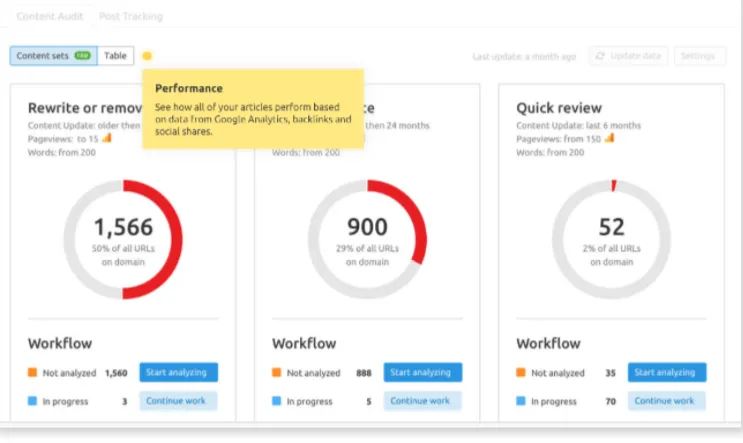
Semrush’s brilliant tool can easily replace any other content analytics tool you are using.
Content Marketplace –
Content Marketplace is a new content marketing tool added to Semrush’s content marketing toolkit, and a much-needed one at that. It is a platform that provides on-demand content for a reasonable price.
Different types of content are available at different prices or you can subscribe to their monthly or annual subscription plans to get discounted rates.

In addition to the content database, you can also find Media Stock, which contains visual content such as pictures, videos, icons, vectors, etc. The Premium plan also includes the Shared Workspaces feature, which lets you collaborate with up to 3 team members.
SEMRush Pricing And Value For Money –
As opposed to other types of SaaS (software as a service) applications, SEO tools like Semrush are more expensive.
This is understandable, as you are not just paying for functionality, you are paying for access to huge amounts of extremely useful data, including information about your competitors.
There are 3 main pricing plans offered by Semrush:
- Pro: $199.95 per month
- Guru: $229.95 per month
- Business: $449.95 per month
Additionally, there is a custom version of the platform, which allows corporate customers to create their own personalized plans (with more generous report and query limits, more user accounts, etc.).

It’s also worth noting that Semrush provides a free trial so you can try it out before you commit to a paid plan. The company has extended its free trial to 30 days for a limited time – you can access it here. The company’s standard version lasts 7 days, but the extended trial is available for a limited time.
A credit card is required to take advantage of the fully-featured trial, which while common practice when it comes to SEO tools is somewhat tedious.
The fees Semrush charges are comparable to those charged by its competitors Moz, Ahrefs, and Majestic (Majestic does offer a lower monthly plan for $49. However, it contains far fewer features than the entry level plans offered by its competitors).
In general, the Semrush plans differ in these areas:
- access to content marketing tools
- access to historical data.
- the number of reports you can run per day
- the number of keywords you can track per month
Paying more gets you more of all the above.
We’ll look closely at some aspects of the Semrush pricing structure so that we can identify where it offers good value – or bad value.
User Account –
The worst thing about Semrush’s pricing structure is that all plans – even the $449.95 ‘Business’ plan – include only one user account or ‘seat’.
For access to Semrush for more than one person in your organization, you’ll need to pay an extra $45 to $100 per person (depending on the plan type) that you select.
Comparatively, all of Semrush’s key competitors generally increase seat counts as you go up the pricing ladder (or charge less for extra seats).
For organisations who are experiencing this issue, Semrush has a ‘Custom’ plan where you can negotiate pricing for a custom number of features with a customized number of users.
Projects –
It is important to keep in mind that a number of Semrush features are only available for domains that have been added to ‘projects.’
A few of the features you find within this category are site audits, backlink audits, on-page SEO analysis, and position tracking.
You can have up to 5 projects running on Semrush depending on the plan you have – the entry-level plan costs $119.95 per month and only supports up to 5 projects.
These limitations won’t necessarily be a deal breaker for every business – but if you manage SEO for a lot of sites concurrently or do a lot of competitor analysis, it is definitely something to keep in mind.
Report Requests –
Semrush offers large numbers of reporting options: on its entry-level plan, you can pull up to 3,000 domain-level analysis reports per day, whereas Ahrefs only allows 175 reports per week on its entry level plan.
As you move up the pricing ladder, comparative generosity continues: the Semrush $449.95 plan’s daily limit for reports is 10,000; Ahrefs’ $399 plan has a limit of 1750 per week.
Competitive Intelligence And Add-Ons –
There are quite a few Semrush features for analyzing competitors’ websites that aren’t available without buying the ‘Trends’ add-on.
By purchasing this, you gain access to:
- The Market Explorer provides demographic and behavioral information about audiences (age, gender, and behavior, seasonal peaks, etc.)
- Analyses of traffic (visitor engagement, traffic sources, desktop & mobile, audience overlap, historic data, geographic information.)
It is disappointing that the monthly fee for this add-on is $200. Most of the above metrics could be considered worthy of an extra charge, but $200 per month seems a bit steep (and in some cases, the add-on can cost more than some of the plans on the platform!).
Furthermore, if you wish to access local search engine optimization features, you may need to pay an extra fee.
Currently, two local SEO add-ons are available: Basic Locations, which cost $20 per month, and Premium Locations, which cost $40 per month.
Both allow you to:
- Provide business information to directories
- Remove duplicate listings
- Monitor local rankings
- Take care of your Google My Business listing and Facebook business page
- Monitor reviews and user feedback
Additionally, a premium Semrush account gives you access to a ‘local heat map’ to show how your customers see your business in relation to other local businesses – and the option to respond to reviews directly within the Semrush interface.
PPC Data –
In the case of projects that combine SEO and PPC, you may find that Semrush offers better value than its competitors.
This is simply because it offers more PPC data – while other tools display simple CPC figures for individual keywords, Semrush provides you with detailed competition and distribution information, live ads, and PPC campaign planning tools.
Customer Support –
The availability and format of customer support are important factors for prospective Semrush users because SEO tools like Semrush are generally complex in nature.
You have three options for customer support with Semrush: live chat, email and phone support. Comparatively, not all competing products offer phone support (Moz doesn’t even provide live chat support).
Like some other SaaS products, Semrush makes its contact information visible from every page – a help chatbox stands out on every page, and a phone number appears prominently in the website’s footer.
There’s no need to go through any tedious ‘find a phone number by searching our help pages’ stuff – help is immediately provided.
Semrush Review Conclusion –
Semrush is an amazing SEO tool that provides all the essential data you’ll need to make SEO successful. The standout features of it for me are its link building and site auditing tools; the former allows you to build backlinks using a CRM-like methodology, and the latter gives you a simple checklist of things you can do to improve your on-page and technical SEO.
What are the main downsides? The only search engine it supports is Google; all accounts come with a single account (‘seat’); and several key features are only available under a single project (with limits to the number of projects you can manage simultaneously).
It’s also a bit disappointing that some of the competitive intelligence features can only be unlocked via a rather pricey $200 per month add-on.
But overall, Semrush is a very good solution that provides you with the key information you’ll need to improve your search rankings. As with all the products we reviews though, we recommend that you try the tool out yourself before purchasing — An Extended Free Trial Is Available Here.
Also Read: Viddyoze Review – Best 3d Animation Software
